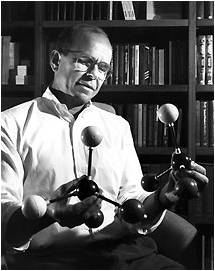
Biography
Unlike most academics engaged in basic research, K. Barry Sharpless has always been exclusively interested in useful chemistry. Since he regards the oxidation of olefins as the single most versatile, powerful and reliable class of transformations in organic synthesis, Sharpless concentrates on expanding the scope of existing oxidative reactions and discovering new ones. Sharpless is best known for discovering three “name” reactions, general methods for catalytic asymmetric epoxidation, dihydroxylation, and aminohydroxylation. His Nobel Prize citation says, “many scientists have identified Sharpless’ epoxidation (discovered in 1980 with Tsutomu Katsuki) as the most important discovery in the field of synthesis during the past few decades.”
Among a newer generation of scientists representing the entire chemical spectrum, from chemical engineering and materials to chemical biology, Sharpless is known for click chemistry, a term he coined in 1998. Inspired by the complexity nature achieves from a handful of building blocks, Sharpless started actively looking in the mid-90s for a way to discover new chemical connectivity and reactivity. Click chemistry did not gain momentum until his group's discovery of CuAAC (the copper-catalyzed azide-alkyne cycloaddition), a near-perfect reaction (2002). Recently the Sharpless group discovered SuFEx, also near-perfect for click chemistry. In concert with the thiol-ene reaction, these three make click chemistry a far-reaching method for drug discovery, chemical biology and materials science.
Descended from one of the original land purchasers in William Penn’s New World venture, K. Barry Sharpless received a Quaker education at the Friends Central School, Haverford, Pennsylvania. In 1963 he graduated from Dartmouth College, where he was introduced, most fortuitously, to the wonders of chemistry by T. A. Spencer. Following graduate research with E. E. van Tamelen at Stanford University, Sharpless completed postdoctoral studies with J. P. Collman, also at Stanford, and at Harvard University with Konrad Bloch.
Sharpless setup his own laboratory in 1970 at the Massachusetts Institute of Technology. Except for several years in the 1970s when he was a member of Stanford’s chemistry faculty, Sharpless remained at MIT until moving to the Scripps Research Institute (TSRI) in 1990. At TSRI, he is W.M.Keck Professor of Chemistry and a member of the Skaggs Institute for Chemical Biology.
In 2011 Thomson Reuters named the top 100 chemists whose papers published in the first decade of the 21st Century achieved the highest citation impact scores: Sharpless was No. 4.